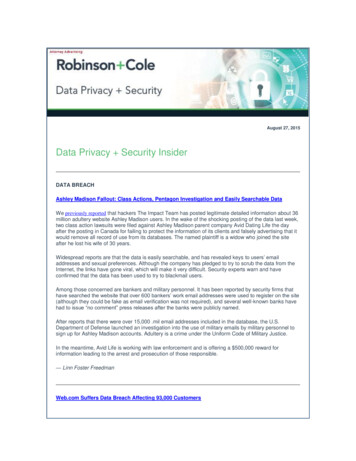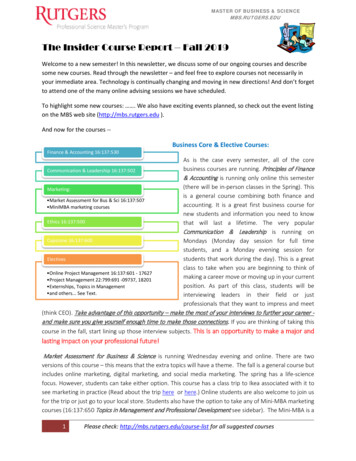
Transcription
Insider Tips for Office Managers & AdministratorsG E T PA I D FA S T E R
Gettingrevenue cyclemanagement rightmeans you getpaid faster.The revenue cycle in healthcare1 is a difficultthing to manage, and even practices thatdo it well find it confusing and frustrating attimes. It’s also an essential part of healthcarebecause you can’t run your clinic without it.Getting revenue cycle management rightmeans you get paid faster and you can collecton more of your total billed charges. We’lldiscuss ways to help you use technologyto your advantage in the revenue cycle andavoid some of the most common mistakes thatcan lead to claims rejections and denials.
WHYYOU’RENOTGETTINGPAIDWhen it comes to therevenue cycle, a lot of thingshave to go right for youto capture the maximumrevenue for the servicesrendered to your patients.Unfortunately a lot of office managers,administrators, and physicians think of the“revenue cycle” as the claims process.In reality it encompasses every part ofthe patient care process and involveseveryone on your team. While the reasonsfor a preventable denied claim or delayedpayment vary, they often boil down toinefficient or broken processes and lackof technology that can aid in gettingpayments faster.COMMON MISTAKES THATDELAY PAYMENT Patient demographic information mustbe correctly entered Insurance information must be correctand up to date The patient’s insurance must bein-network and cover the procedure Prior authorization must beobtained when necessary Documentation in the EHR mustclearly show services provided andmedical necessity CPT and ICD-10 codes must becorrectly appliedInaccurate coding Claims must be filed within the specifiedtimelines for each payorMissed deadlines to submit a claim orrework and resubmit a denied claim Denied claims must be reworkedand resubmitted (also withinspecified timeframes)Not informing patients about theirpayment responsibility upfront Patient balances must bebilled and collectedNot following up on patients’unpaid balancesThe most common mistakes thatcan delay your payment and make itharder to collect the highest percentof allowable charges include:Data entry errors at the time of schedulingErrors in manual data entry wheninformation is transferredbetween systemsIncomplete documentation
HOW PRACTICE MANAGEMENT SOFTWARE CANIMPROVE YOURREVENUE CYCLEOne of the most important tools for a clinicis medical billing and practice managementsoftware2. Where many practices fall short ishaving separate systems that don’t worktogether, or not using the available technologyto its maximum capacity to improve your revenuecycle. Practice management software andmedical billing software can dramaticallyimprove your ability to collect revenue quicklyand maximize what you are able to collect.SOFTWARE INTEGRATIONA common buzzword in healthcare is the ideaof “integration,” but many clinics do not have trulyintegrated software. Disparate systems patchedtogether using APIs3 often cannot share dataseamlessly, leaving information gaps orrequiring manual data entry that slows downyour revenue cycle.A quick fix (i.e., an API) to connect two existinglegacy systems might seem like a cost-savingmeasure—and probably is less expensive thana new, fully integrated practice managementsystem in the short-term—but it will cost you alot in the long run by creating inefficiencies andcontributing to lost revenue.Integrated software4 allows patient data andclinical data to flow seamlessly through theentire patient journey:SchedulingGather accurate patient demographicsInsurance verificationEnsure correct information to bill the right payor.EHRTrack and manage clinical notes anddocumentation essential for claims.Claims submissionCode properly based on care provided andsubmit information to payors based on theirspecific requirements and timelines.Denial managementFollow the claim to ensure it’s been paid andwasn’t denied or rejected; have a process tofollow up on denied claims immediately.Patient collectionsGenerate a bill for any unpaid balance thatwas not covered by insurance and send itto the patient.Bill payCollect patient payments and allocate them tounpaid balancesAll of these steps require information about thepatient, the payor, and the clinical care. If thisinformation cannot be transmitted betweenprograms quickly and accurately it leads tounnecessary errors and delays. Truly integratedcloud-based practice management software5shares a common database accessible by staffand physicians with a single click.IMPROVE & AUTOMATEELIGIBILITY VERIFICATIONMillions of claims6 are denied every year due toinsurance eligibility errors, such as: Services not covered by thepatient’s insurance Insurance coverage terminated prior to thepatient’s appointment Patient’s maximum benefit was already met Your clinic is out of network Procedure requires prior authorization thatwas never obtainedThese denials are frustrating to you and yourphysicians, but also to your patients. The worstpart of a denied claim is the fact that most couldbe avoided with proper insurance eligibilityverification. Practice management softwarecan automatically check for issues or errors atthe time a patient schedules the appointment,and again right before the appointment occurs(checking twice can help you avoid a situationwhere insurance has been terminated or haschanged since they scheduled the appointment).Batch checks can quickly verify multiplepatients without requiring any manual workby front office staff.PROVIDE COST ESTIMATESThe way payments work in healthcare—claimssubmission to a third-party insurance payor afterservices are rendered, and collections that occurmonths after the patient visit—creates confusing,bureaucratic, and opaque pricing. This frustratespatients, providers, and administrators.Four in 10 adults7 said they would have toborrow money, sell something, or skip payingan unexpected bill of 400 or more in a 2018Federal Reserve report. Medical bills that areseveral hundred or several thousand dollars—especially when the patient isn’t prepared forthat cost—are unlikely to be paid. Black Book’sRevenue Cycle Management survey found that83 percent of clinics8 with five or fewer physiciansstruggle with delayed payments from patientswith high deductible health plans (HDHPs).As healthcare consumerism increases, patientsare looking for clear information about whattheir costs will be for healthcare services. ATransUnion survey9 showed that 75% of patientsuse provider or insurance websites to estimatecosts before seeking care. Average out-of-pocketcosts10 exceeded 1,800 in 2017 and areclimbing by double-digit rates year over year.Only half (51%) of patients in the TransUnionsurvey said they received clear informationabout costs before getting treatment, but 65%said they are more willing to pay when theyknow the costs upfront.Provide an estimate of the total patientresponsibility before the appointment,especially for people without insurance or with ahigh-deductible plan who will be shouldering asignificant portion of that cost. Front officestaff should be collecting as much as theycan at the time of service.ELIMINATE DATA ERRORSAnother common reason that payment getsdelayed is simply that the information on theclaim is wrong. It might be an error in thepatient’s social security number, a transposed ormissing number in the insurance ID, or the wrongdate of birth. Properly training staff todouble-check work can help reduce theseerrors, but there are also ways your practicemanagement software can help:Integrated systems with a single databaseeliminate the need for multiple rounds ofmanual data entry, which is a commonreason for data errors11.Electronic check-in processes12 allow patients toview and double-check their own data before theappointment, and correct errors.Clearinghouse services13 check for errors likeoutdated or incorrect CPT codes.REPORTINGReporting is perhaps the most underappreciatedway to improve the revenue cycle, get paidmore, and get paid faster. Your software shouldgenerate automated reports that you andyour physicians can easily analyze for keyperformance indicators (KPIs)14 like:First-pass resolution rate: the number of claimsthat get through without denials on the firstsubmission (aim for a FPRR of 96% or higher)Net collection rate: the total amount you collectas a percentage of allowable charges (aim for95% or higher)Claims denial rate: what percent of claims aredenied (aim for a denial rate of 5% or lower)Days in accounts receivable: how long it takesyou to collect revenue (aim for an average of30-35 days)Bad debt write-offs: allowable charges that youcannot collect and write off as bad debt (aim forless than 1.75% of total charges15)
TIPS TOSPEED UPPAYMENTIN YOUR CLINICExperts in revenue cycle management16 agree that automation andtechnology hold the most promising keys to improving efficiency.To sum up what we discussed above, are a few tips to get paid faster in your clinic:Verify patient information on the first phone callName, birthdate, insurance ID.Verify your provider information on all claims submissionsAddress, name, contact information, NPI.Verify insurance eligibility twiceOnce at the time of scheduling, a second time the day before the appointment.Use software automation features to make this easy.Collect upfront when possibleProvide an estimate of charges to the patient and collect as much as youcan either before (at check-in) or immediately after the appointment(at checkout).Provider documentationTrain providers and staff on proper documentation so coders andbilling staff can quickly verify and complete claims.Stay updated on changing codesUse the most recent CPT17 or ICD-1018 codes, and code to thehighest level of specificity to get maximum reimbursement. Oruse a third-party medical billing service if your clinic is smallerand you lack the resources to do it in-house.Use a clearinghouseThese services check every claim for errors, includinginsurance eligibility, coding errors, and other simple thingsyou can fix before submitting the claim.Create workflows for denied claimsImmediately investigate and re-work denied claims so youcan submit them before the deadlines pass.Review key revenue cycle metrics regularlySit down with physicians (and executives in medium-sizegroup practices) to review metrics and identify areas ofconcern early. Act immediately to correct problems withactionable solutions.
Get started with better software toimprove your RCMTake the first step toward better revenue cycle management with an integrated software solution fromAdvancedMD. Contact us today19 to schedule a live demo and learn how we can help your practice.REFERENCES:1. healthcare-revenue-cycle-management2. ate-practice3. api4. l-todays-health-systems/5. -of-cloud-based-saas-software-for-your-business6. msinitially-denied-meaning-billions7. 05.pdf8. s-29-percent-black-book-survey-300542031.html9. seekmedical-treatment/10. https://www.hfma.org/topics/trends/61657.html11. 38/12. ns-digitizing-admin-tasks/13. e/clearinghouse/14. ckingand-using-practice-performance-in15. -operations-conference/session-handouts/con301 davisscott-sagarra making-bank-managing-an16. cy17. es/ama-releases-2021-cpt-code-set18. 19. /live-demo/(800) 825-0224advancedmd.com 2021 AdvancedMD, Inc. All rights reserved.
Errors in manual data entry when information is transferred between systems Incomplete documentation . Properly training staff to Your clinic is out of network Procedure requires prior authorization that . AdvancedMD. Cont











